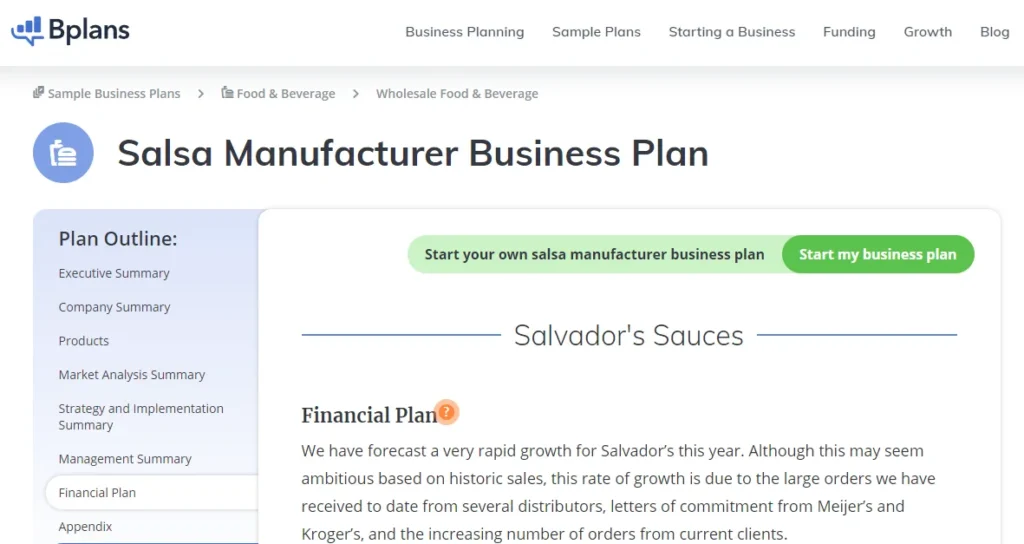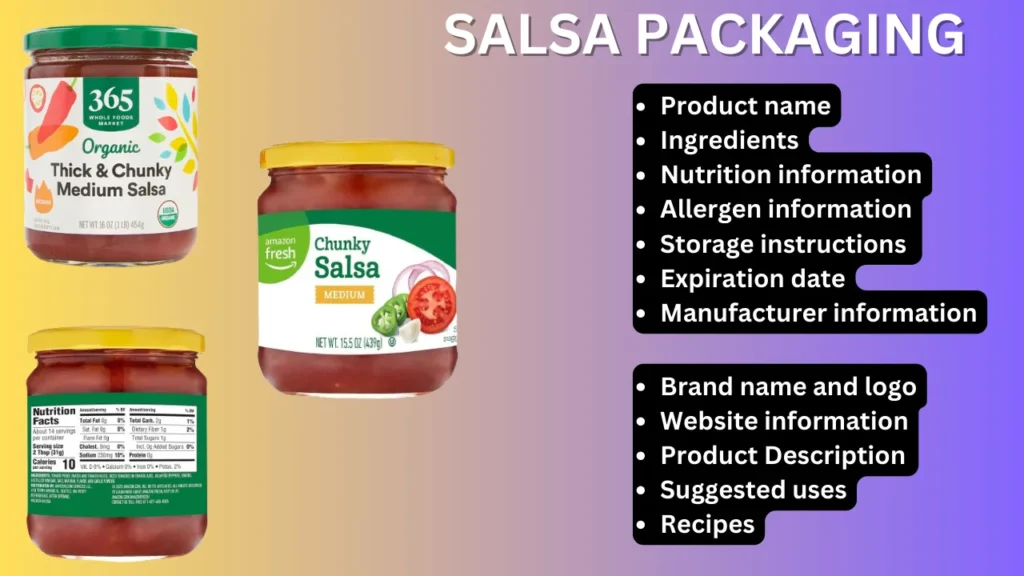Are you tired of the same bland salsa options at the store?
Do you dream of creating and sharing your unique flavor profiles with the world? If so, starting your salsa business might be the perfect recipe for success!
Have you ever wondered how to start a salsa business? You are in the right place. This blog post will discuss the steps to start the business.
With the growing demand for different flavoring salsa, ingredients variety, and healthy food products, starting a business in this niche market can be a profitable idea.
Whether you are new to selling salsa or an existing business owner who wants to grow their business by increasing production or with a proper marketing strategy.
Are you ready? Let’s get started.
What is salsa?
Salsa is a popular condiment and sauce originating in Latin American countries and is most popular in Mexico.
The word “salsa” is Spanish for “sauce,” and there are many varieties of salsas.
Salsa is made with tomatoes, onions, peppers, and spices.
It is used for many purposes: topping tacos, burritos, and nachos.
Salsa is popular worldwide, including in the United States, Mexico, Colombia, Puerto Rico, Cuba, and other parts of the world such as Spain, France, Italy, and the United Kingdom.
The name can differ from country to country, but the ingredients, taste, use, and purposes are mostly similar.
Salsa and sauce are popular condiments used for the same purpose, but our audience may be confused; here is the difference.
| Sauce | Salsa |
|---|---|
| Made with tomatoes, onions, peppers, spices, and other condiments. | Made with tomatoes, onions, peppers, and spices. |
| It can be smooth or chunky. | Typically chunky. |
| Popular all over the world. | Especially popular in Latin America |
Is salsa selling business profitable?
Yes, a salsa-selling business can be a profitable idea.
However, it depends on location, market demand, competition, product quality, and customer response.
Here are some other factors that influence the profitability such as:
- Cost of ingredients
- Production cost (packaging, labor, overhead)
- Marketing and advertising costs
- Pricing strategy focusing on market competition

According to the report by einnews.com, In the year 2022, the global salsa sauce market is seen to be valued at US$3.2 billion, which is promisingly projected to grow to US$7.85 billion by 2033, driven by a CAGR of 8.5%.
Analyze the trend of “salsa” to learn the industry trend and fluctuation.
You can use Google Trends, Semrush, Ahrefs, and other market research tools.
The salsa profit margin also depends on (the cost of ingredients, making process, overhead cost, selling quantity, competition, and consumer demand).
The current salsa profit margin is around 20-40%, depending on the business model and cost of ingredients.
To increase the chances of profitability, follow the steps:
- Add a variety menu option
- Sell at different locations
- Sell both online and offline
- Focus on salsa quality and taste
- Develop a Brand identity
- Offer unique flavors and taste
- Use fresh and high-quality ingredients
- Packaging (to sell bottled salsa)
- Marketing and promotion is vital to success
Pros and cons of the salsa business:
Pros
- Growing market demand
- Versatile product options
- Low barrier to entry
- Good profit potential
- Growing demand
- Start-from-home opportunity
- Potential for repeat customer
- Different menu opportunities
Cons
- The market can be competitive
- Regulations and compliance
- Seasonal demand fluctuations
- Challenges in ingredient sourcing
- Limited product shelf life.
How to Start a Salsa Business

You can find endless possibilities and opportunities, whether traditional recipes or classic flavors, so create a unique flavor to attract more customers and convert them into repeat customers.
You can also sell from local farmer’s markets to online platforms; with the growing trend of digital media, social media, and online marketing, selling salsa is not difficult.
Follow the steps to turn your hobby into this niche-based business.
1. Decide your business idea
The first step is to decide on a business idea. We discuss three popular business ideas – bottled salsa, salsa shop, and salsa-making business.
All three ideas have the same basic concept: produce and sell salsa.
The basic requirements and process for all three business ideas.
Requirements:
- A commercial kitchen space
- Food processing equipment
- Packaging materials (bottles, jars, and lids)
- Labels and marketing materials
Process:
- Sourcing ingredients
- Preparation or making
- Packaging and labeling
- Market and sell the salsa.
Bottled salsa:
You can produce and sell salsa in packaging with bottles to retail stores, restaurants, and other businesses.
The process is producing salsa in large batches, packaging in bottles, labeling, and selling them directly to consumers by following the food safety regulations.
Salsa shop:
To start a physical shop, choose a high-potential location where customers come to taste your salsa. Also, you can salsa with Mexican food items and drinks such as tacos, burritos, etc.
Salsa-making business:
You can also set up a manufacturing or production unit to produce salsa in bulk.
Your target customers include restaurants, food manufacturers, wholesale buyers, Mexican food shops, and individual customers.
Hope you understand the business model and ideas; let’s move to the next step.
2. Develop a salsa business plan

A solid business plan is essential for your salsa business to grow and run on the right path. So, develop a successful business plan based on operations, goals, and concepts and focus on your target market.
Before writing a plan, proper market research, competitive analysis, and growth forecasting are essential. Also, you need to find unique opportunities to grow in a competitive market.
Top 7 reasons to write a business plan for your business:
- To define the business goals and strategies
- Required for developing a financial plan
- A well-organized business plan helps to get funding
- Provide a roadmap and path to work on the right strategy
- Help in identifying and addressing potential risks
- To make better business decisions
Follow the given points to write a business plan:
- Market research: Your Plan must include relevant market data – Analyze the salsa industry, your target audience (demographics, psychographics, and needs), and competition. Conduct a SWOT analysis to identify the strengths and weaknesses of your competitors.
- Company description: Write about your salsa business ownership (sole proprietorship, LLC), your plan to start, and your unique selling proposition, business model, sale strategy, etc.
- Product Line: Explain different types of salsa, the location to set up a production line, menu items, pricing, equipment, ingredients, and production process.
- Marketing strategy: Outline how you want to promote your salsa and reach customers to your shop, such as – Social Media, word-of-mouth, branding-logo and business name, website, etc.
- Staffing and workforce: To manage your business, write about hiring skilled staff and an experienced team, their role, hiring plan, job description, salary, increment, etc.
- Operations plan: Location, facilities, supplier information – for buying fresh ingredients, equipment, ongoing requirements, and distribution plan.
- Financial plan: Estimate the startup cost, plan for fundraising, profit statement, etc.
Hope those outline points and basic information are helpful.
To write a business plan more strategically, you can read blog posts.
Popular sources where you can find templates for writing a plan are:

- Bplans
- SBA
- SCORE
- LivePlan
- TemplateLab
- Template.net
3. Setup your commercial kitchen
You need a well-equipped kitchen in a high-demand location to operate a successful salsa business.
When you choose a location for your commercial chicken, know the zoning requirements, size of the kitchen, layout, accessibility, and your target market.
Is a commercial kitchen really important for the salsa business?
The answer is no. A commercial kitchen is not essential, but it can be helpful if you plan to produce a large quantity of salsa or want to start professionally.
Should you buy or rent a location for the business?
Buying or renting a location for your salsa business depends on factors like budget, business goals, and market conditions.
Rent a location for opening a shop, for a production line, or starting an online business.
Best ideal location for opening a physical shop:
Find a location with high foot traffic, where people love salsa, and where there is high selling potential. You can start your setup near:
- Tourist destinations
- Farmers’ markets
- Urban food hubs
- College campuses
- Food festivals and events
- Tech and business parks
- Grocery stores
Buy kitchen supplies and equipment:
Running a salsa shop requires kitchen supplies, serving equipment, a table, a chair, cleaning supplies, etc.
- Buy cooking equipment: Stoves, ovens, large pots, and mixers.
- Refrigeration equipment: Commercial refrigerators and freezers.
- Food processing equipment: Blenders, food processors, and juicers.
- Safety equipment: Fire extinguishers, first-aid kits, and safety signage.
- Smallwares: Knives, cutting boards, mixing bowls, measuring tools, and utensils.
4. Develop your salsa recipe

Developing a unique salsa recipe can provide a unique taste to your customer, but it is not a simple process. It requires a good understanding of different ingredients, practice, perfection in salsa making, and cooking skills.
You must experiment with different ingredients, flavors, and cooking processes. That can help you better understand how the taste is made with different ingredients and flavors.
Different types of salsa with their unique ingredients:
The base ingredients in salsa are tomatoes, onions, peppers, cilantro, and lime juice.
Here are the additional ingredients needed to prepare specific salsa flavors and tastes.
- Salsa Roja: Tomatoes, onions, peppers, cilantro, and lime juice.
- Salsa macha: Peanuts, sesame seeds, and chiles
- Salsa negra: Chocolate, mole paste, and chiles
- Salsa borracha: Beer, tequila, and chiles
- Salsa de mango: Mango, habaneros, and red onion
- Salsa de piña: Pineapple, jalapeños, and cilantro
- Salsa de aguacate: Avocado, serranos, and lime juice
Other popular salsa recipes:
- Salsa Verde (green salsa)
- Pico de Gallo
- Salsa Fresca
- Pineapple Salsa
- Corn Salsa
- Black Bean Salsa
- Avocado Salsa (Guacamole)
- Salsa Habanero (Spicy Habanero Salsa)
- Salsa Taqueria (Taco Salsa)
So, if you are new to making salsa, creating a unique flavor from day one cannot be easy. First, understand the base ingredients and making process, then develop your skills with time.
To learn the making process you can get training, practice yourself with an experienced person, and learn from online courses.
Watching YouTube tutorials and reading blog posts can help you to learn the basics.

5. Source your ingredients
Gather the essential ingredients and supplies for making salsa, but finding the right supplier for buying fresh and high-quality ingredients (mainly tomatoes) is also important.
When you go to buy ingredients, check the quality and price:
- Quality: Choose fresh, high-quality ingredients
- Price: Compare the prices from different suppliers
- Selection: Decide how much quantity to buy.
- Reliability: Choose a reliable supplier for fresh and lower prices.
What ingredients do you need to make salsa?
- Tomatoes
- Onions
- Peppers (such as jalapeños, serranos, or habaneros)
- Cilantro
- Lime juice
- Salt
- Pepper
- Garlic (optional)
Where do you source your ingredients?
- Buy from local farmers:
- Supports your local community
- It gets you fresh, high-quality ingredients
- Can find them at farmers’ markets, CSAs, and online
- Buy from wholesalers:
- Can offer lower prices on ingredients
- It is a good option if you plan to produce a large quantity of salsa.
- May have to buy in bulk
- Buy from grocery stores:
- Convenient option
- Check the price (can be High)
How do you find a supplier for an ingredient?
To find the best ingredient supplier, you can visit the farmer’s market, partner with the farmer, check online directories and offline sources, and get details by asking other business owners – (restaurants or grocery stores).
Partner with local farms or farmers (for tomatoes); they can provide you with the best quality ingredients at the right price.
Buy in bulk: To get more discount, you should consider buying ingredients in bulk.
6. Salsa packaging and labeling

Packaging and labeling are crucial for a company to sell the product and create branding in the market.
However, If you want to start a home-based business with a commercial kitchen set up and are looking to sell them online (bottled salsa), then the package is vital for success.
Selling salsa through a restaurant or shop may not need high qualifying packaging or labeling; you can serve salsa with plates, bowls, or plastic packaging material, but the packaging is a must for delivery online selling.
Design your label:
You need to create your label professionally, including all information.
Add the following information:
- Product name
- Ingredients
- Nutrition information
- Allergen information
- Storage instructions
- Expiration date
- Manufacturer information
For branding, you can add more information about your company:
- Brand name and logo
- Website and social media information
- Product Description
- Suggested uses
- Recipes
Types of packaging:
Depending on your brand and product, explore different packaging methods and find the best available salsa packaging options, such as glass jars, plastic containers, or pouches.
Buy packaging supplies:
Procure essential packaging supplies like jars, lids, seals, and labels.
Design and print labels:
Invest in a professional label designer to create an interactive label, or you can find a designer from freelancing sites like Upwork, Fiverr, or Freelancers.
Work with a label printing service or use label templates to create and print your salsa packaging labels; after creating the packaging sticker and everything, package your salsa.
7. Get permits, licenses, And Insurance

Obtain the necessary licenses and permits to fulfill the local or state legal regulations.
These legal requirements ensure compliance with regulations and protect both the business owner and customers.
Permits may include health department approvals, food handling permits, etc.
- Register your business and for taxes: Choose a business entity (sole proprietorship, partnership, LLC, or corporation). Depending on your business goal, you can choose an entity type (focusing on personal liability, taxation, ownership, and flexibility).
- Business license: Contact your local authority to obtain a license from the local or state government.
- Food handler’s license: Some states require food handlers’ permits to operate a food-based startup.
- Food safety: Follow all food safety rules, and produce and sell them safely.
- Food labeling: You need to label your salsa according to the regulations of the FDA.
- FDA regulations for salsa: This is important to ensure your safety and accurate labeling, mainly including (Good Manufacturing Practices (GMPs), food labeling, and acidification.)
Consult a legal attorney for more information, because it depends on your state, country, location or local area regulations, You must comply with all applicable regulations.
Obtain business insurance:
Obtain the following requirements to secure your business from accidents or injuries.
Proper documentation and the right business insurance help your business to cover up and create a solid foundation for your successful salsa business.
- General liability insurance: For bodily injury, property damage, and advertising injury claims.
- Product liability insurance: For food poisoning and allergic reactions.
- Commercial property insurance: Important for buildings, inventory, equipment, and furniture coverage.
Research for more helpful information, and consult an insurance agent.
8. Calculate startup cost and raise funds
Calculate how much you need to start the business.
By creating a proper budget, you can easily arrange funds needed from different sources; we provide a table of general estimations for your idea.
| Expense category | Estimated cost |
|---|---|
| Ingredients and supplies | $2,000 – $5,000 |
| Equipment and kitchen setup | $5,000 – $10,000 |
| Packaging and labeling | $1,000 – $2,000 |
| Permits and licensing | $1,000 – $2,000 |
| Marketing and promotion | $1,000 – $2,000 |
| Initial inventory | $2,000 – $5,000 |
| Utilities and rent | Variable |
| Legal and Accounting | $500 – $1,000 |
| Working capital (for the first few months) | Variable |
Total estimated startup costs: $12,500 – $27,000 (excluding working capital).
Depending on your budget, location, operation size, and focusing on the target market, you can know how much funds are needed.
Conduct proper research, create a business plan, and start raising funds.
- Self-funds, friends, and family
- Bootstrap your business
- Get a business loan from a bank
- Apply for government grants (eligibility matter)
- Crowdfund your salsa business
9. Focus on branding

Branding and creating an identity in the market are important for building strong recognition and customer trust, which helps grow your business in the competitive food industry.
By investing your time and effort in researching your competitors, you can develop a strong brand identity for your salsa business.
A website is needed to brand your business; a name, logo, and strong social media presence are essential.
Choose a business name:
Choose a unique, short, attractive, niche-related, copyrighted, free, and web-friendly name for your business.
Create a business website:
Develop a professional website with proper user-friendly customization and the basic requirements you need (hosting, domain name, themes, and plugins).
Depending on your goal, you can host your website on a reliable server or choose the best CMS (WordPress, Joomla, Magneto, Drupal) for creating a website that is easy to customize.
Social media presence:
Online social media presence is also important for branding; sharing images, recipe ideas, and cooking videos can create a user base interested in salsa.
Create social media profiles on (Facebook, Instagram, Twitter, and TikTok to share your content), and most importantly, create a YouTube channel to share video content with a large audience base.
10. Market your salsa
No matter the size or scale of your business.
Marketing and promotion are part of building a potential customer base.
Initially, attracting customers to your shop is difficult, but you can achieve this goal by following some strategic marketing ideas.
Firstly, plan for a grand opening with proper decoration and preparation.
Offer free salsa for free trials; you can charge a very small amount, focus on providing high-quality service, and maintain cleanliness and hygiene.
Learn about different digital marketing and promotion ways to market your venture freely, such as social media marketing by sharing content on different platforms like Facebook, Instagram, TikTok, or YouTube.
Share your recipe videos, photos, and different types of menu options.
Where to sell your salsa?
You can sell salsa on different platforms or mediums:
- You can sell at farmer’s market
- Online selling is also a good idea
- Through social media promotion or direct sale
- Sell locally by opening a restaurant or shop.
- You can set up your food truck.
Frequently Asked Questions (FAQs)
Can you sell homemade salsa?
You can sell homemade salsa; check your local and state regulations first. Focus on building a strong customer base with different marketing strategies – social media can be the best way.
Is it worth it to make your salsa?
As a customer – Yes, it is worth it to make your salsa if you want a fresh, flavorful, and customizable salsa, If there is any salsa shop in your nearby area, then bought salsa can be a more worth it option.
What is the profit margin of salsa?
The profit margin of salsa is between 20% – 40%; it depends on location to location, ingredients, flavor, and cost of production.
Can you make money making salsa?
Yes, you can make money making salsa; the process is simple (salsa-making, packaging, pricing, marketing, and selling), but it is important to have a realistic business plan.
How much can you sell homemade salsa for?
You can sell homemade salsa for around $3 to $8 per jar, depending on the ingredients, the size of the jar, and the local market price.
Conclusion
To start a salsa shop or business successfully requires proper research, dedication, time, effort, hard work, planning, and funds.
Selling salsa is a most profitable and growing venture, as people are looking to eat healthy, flavorful food, and demand and competition are increasing.
As we discussed every step in this guide, such as unique recipes, ingredients, packaging, branding, marketing, and sales, follow and implement those steps in your venture and make this line more profitable.
Hopefully, you might have learned some effective points; if you have other doubts or suggestions related to this blog post, ask me in the comments.
Related blog post:





